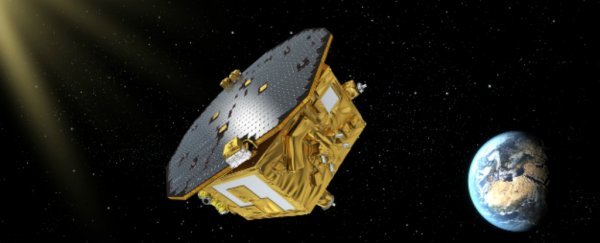Scientists working with the Laser Interferometer Space Antenna (LISA) Pathfinder – an experimental spacecraft designed to study gravity – have announced that they've been able to accurately measure tiny amounts of movement that are smaller than the width of an atom.
While this news is remarkable on a technical level, the really exciting part is the successful measurement will likely lead to a better way for us to detect gravitational waves – ripples in the curvature of space-time that Einstein predicted in his general theory of relativity, and which were detected for the first time earlier this year.
To pull off the feat, the team from the European Space Agency (ESA) parked the spacecraft 1.5 million kilometres (932,056 miles) away from Earth in a region of space where the gravitational pull of both Earth and the Sun are cancelled out by one another, explains Tarek Bazley for Al Jazeera. This region is known as a Lagrange point.
This means that the objects onboard the craft – two 1.9-kilogram (4.1-pound) cubes of solid gold-platinum alloy – are actually in a free-fall through space, floating exactly 37.5 centimetres (14.8 inches) apart.
Since the cubes are in free-fall, they technically shouldn't move at all (outside of the speed they are already moving inside the craft, which is in orbit around the Sun). If they do, it's likely because they were influenced by gravitational waves, which ripple out over the entire Universe, causing objects to wiggle ever so slightly.
With this in mind, the researchers were able to verify that the craft is capable of measuring movements at the femtometre scale, which is one millionth of a billionth of a metre, explains Jesse Emspak for Smithsonian Magazine.
While the Pathfinder on its own isn't big enough to detect gravitational waves – for that, the objects measured must be super, super far apart, so the wave can hit both of them at slightly different times – it suggests that researchers can successfully use environments in space that are unaffected by the forces lingering directly outside its windows.
"We wanted to see picometer scale motions," the mission's senior scientist Martin Hewitson told Smithsonian Magazine. "It's more than 100 times better than [observations] on the ground."
When researchers from the Laser Interferometer Gravitational Wave Observatory (LIGO) detected gravitational waves earlier this year, they had to use lasers that were only 4 kilometres (2.5 miles) apart, which is much too small to accurately detect gravitational waves. To counter this, they were able to bounce the lasers back and forth, creating a distance of 1,118 kilometres (695 miles). At this distance, reports Emspak, gravitational waves can be detected, but only ones that measure 100 to 1,000 Hz.
Since the LISA Pathfinder was able to measure the movement so accurately, the team will soon embark on the next phase of the mission, with a device called the Evolved Laser Interferometer Space Antenna (eLISA).
In this next stage, three separate spacecraft will orbit the Sun in the same sweet spot LISA is in. These crafts will link up to form an L shape, with each of them 999,402 kilometres (621,000 miles) apart.
At such a great distance, the team should be able to accurately detect gravitational waves that are only 0.0001 to 1 Hz, a much more sensitive system than what LIGO had to work with.
Using the same laser measuring techniques that were just validated inside the LISA Pathfinder, the team says they will be able to measure movements that are only a few trillionths of a metre.
Understanding gravitational waves will give us a whole new view of how the Universe works. The fact that we can detect them at all is astonishing, and the successful measurement on board the LISA Pathfinder shows we're already getting better at it.
"When we open the gravitational wave window to the Universe we are seeing completely new objects, things that we have never been able to see before and never will be able to see using [the] electromagnetic spectrum," LISA Pathfinder team member Paul McNamara told Al Jazeera. "We're really on the cusp of observing the Universe in a whole new way."
"We now know gravitational waves are detectable - they exist," is how the ESA's Directorate of Science, Fabio Favata, put it. "[A]nd now, thanks to LISA Pathfinder, we know that we have sufficient sensitivity to observe them from space, and therefore a new window to the Universe has been opened."
While there is still a lot of work for researchers to do to get eLISA off the ground, it's already exciting to think about the possible data it will eventually collect.
The findings are published in Physical Review Letters.
